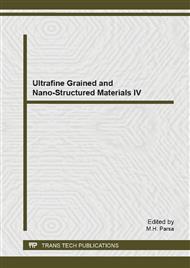[1]
R. Hang, X. Huang, L. Tian, Z. He, B. Tang, Preparation, characterization, corrosion behavior and bioactivity of Ni2O3-doped TiO2 nanotubes on NiTi alloy, Electrochimica Acta 70 (2012) 382– 393.
DOI: 10.1016/j.electacta.2012.03.085
Google Scholar
[2]
S. Bernard, V. Balla, N. Davies, S. Bose, A. Bandyopadhyay, Bone cell–materials interactions and Ni ion release of anodized equiatomic NiTi alloy, Acta Biomaterialia 7 (2011) 1902–(1912).
DOI: 10.1016/j.actbio.2011.01.004
Google Scholar
[3]
F.T. Cheng, P. Shi, G.K.H. Pang, M.H. Wong, H.C. Man, Microstructural characterization of oxide film formed on NiTi by anodization in acetic acid, Journal of Alloys and Compounds 438 (2007) 238–242.
DOI: 10.1016/j.jallcom.2006.08.020
Google Scholar
[4]
J. Kawakita, M. Stratmann and A. Hassel, High Voltage Pulse Anodization of a NiTi Shape Memory Alloy, Journal of The Electrochemical Society, 154 (2007) 294-298.
DOI: 10.1149/1.2720768
Google Scholar
[5]
N. Bayat, S. Sanjabi, Z.H. Barber, Improvement of corrosion resistance of NiTi sputtered thin films by anodization, Applied Surface Science 257 (2011) 8493–8499.
DOI: 10.1016/j.apsusc.2011.05.001
Google Scholar
[6]
W. Chrzanowski. E. A. Abou Neel. D. A. Armitage. J. C. Knowles, Surface preparation of bioactive Ni–Ti alloy using alkali, thermal treatments and spark oxidation, J Mater Sci: Mater Med (2008) 1553–1557.
DOI: 10.1007/s10856-008-3374-9
Google Scholar
[7]
M.H. Wong, F.T. Cheng, H.C. Man, Characteristics, apatite-forming ability and corrosion resistance of NiTi surface modified by AC anodization, Applied Surface Science 253 (2007) 7527–7534.
DOI: 10.1016/j.apsusc.2007.03.055
Google Scholar
[8]
R. Qin, D.Y. Ding, C.Q. Ning, H.G. Liu, B.S. Zhu, M. Li, D.L. Mao, Ni-doped TiO2 nanotube arrays on shape memory alloy, Applied Surface Science 257 (2011) 6308–6313.
DOI: 10.1016/j.apsusc.2011.02.072
Google Scholar
[9]
V. Togan, S. Grassini, G. Ionita, Surface modification of NiTi alloy by anodizing, Metalurgia International (2012) 20-24.
Google Scholar
[10]
C.L. Chu, R.M. Wang, L.H. Yin, Y.P. Pu, P.H. Lin, Y.S. Dong, C.Y. Chung, K.W.K. Yeung, P.K. Chu, Effects of anodic oxidation in H2SO4 electrolyte on the biocompatibility of NiTi shape memory alloy, Materials Letters 62 (2008) 3512–3514.
DOI: 10.1016/j.matlet.2008.03.030
Google Scholar
[11]
C. L. Chu, R. M. Wang, T. Hu , L. H. Yin, Y. P. Pu, P. H. Lin, Y. S. Dong, C. Guo, C. Y. Chung, W. K. Yeung, Paul K. Chu, XPS and biocompatibility studies of titania film on anodized NiTi shape memory alloy, J Mater Sci: Mater Med (2009) 223–228.
DOI: 10.1007/s10856-008-3563-6
Google Scholar
[12]
P. Shi, F.T. Cheng, H.C. Man, Improvement in corrosion resistance of NiTi by anodization in acetic acid, Materials Letters 61 (2007) 2385–2388.
DOI: 10.1016/j.matlet.2006.09.020
Google Scholar
[13]
C. Huang, Y. Xie, L. Zhou and H. Huang, Enhanced surface roughness and corrosion resistance of NiTi alloy by anodization in diluted HF solution, Smart Mater. Struct. 18 (2009) 24003-24009.
DOI: 10.1088/0964-1726/18/2/024003
Google Scholar
[14]
T. Kokubo, H. Takadama, Biomaterials 27 (2006) 2907–2915.
Google Scholar
[15]
ASTM Standard G 61-86, Conducting Cyclic Potentiodynamic Polarization Measurements for Localized Corrosion Susceptibility in Iron-, Nickel-, or Cobalt-Based Alloys, ASTM Standards, ASTM, Philadelphia, PA, USA.
DOI: 10.1520/g0061-86r09
Google Scholar
[16]
S. Li, G. Zhang, D. Guo, L. Yu and Wei Zhang, Anodization Fabrication of Highly Ordered TiO2 Nanotubes, J. Phys. Chem. C (2009) 12759–12765.
DOI: 10.1021/jp903037f
Google Scholar
[17]
J. Kim, K. Zhu, Y. Yan, C. Perkins and J. Frank, Microstructure and Pseudocapacitive Properties of Electrodes Constructed of Oriented NiO-TiO2 Nanotube Arrays, Nano Lett. 2010, 10, 4099–4104.
DOI: 10.1021/nl102203s
Google Scholar
[18]
B. Chen, J. Hou and K. Lu, Formation Mechanism of TiO2 Nanotubes and Their Applications in Photoelectrochemical Water Splitting and Supercapacitors, Langmuir 2013, 29, 5911−5919.
DOI: 10.1021/la400586r
Google Scholar


